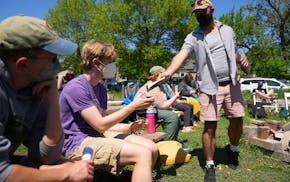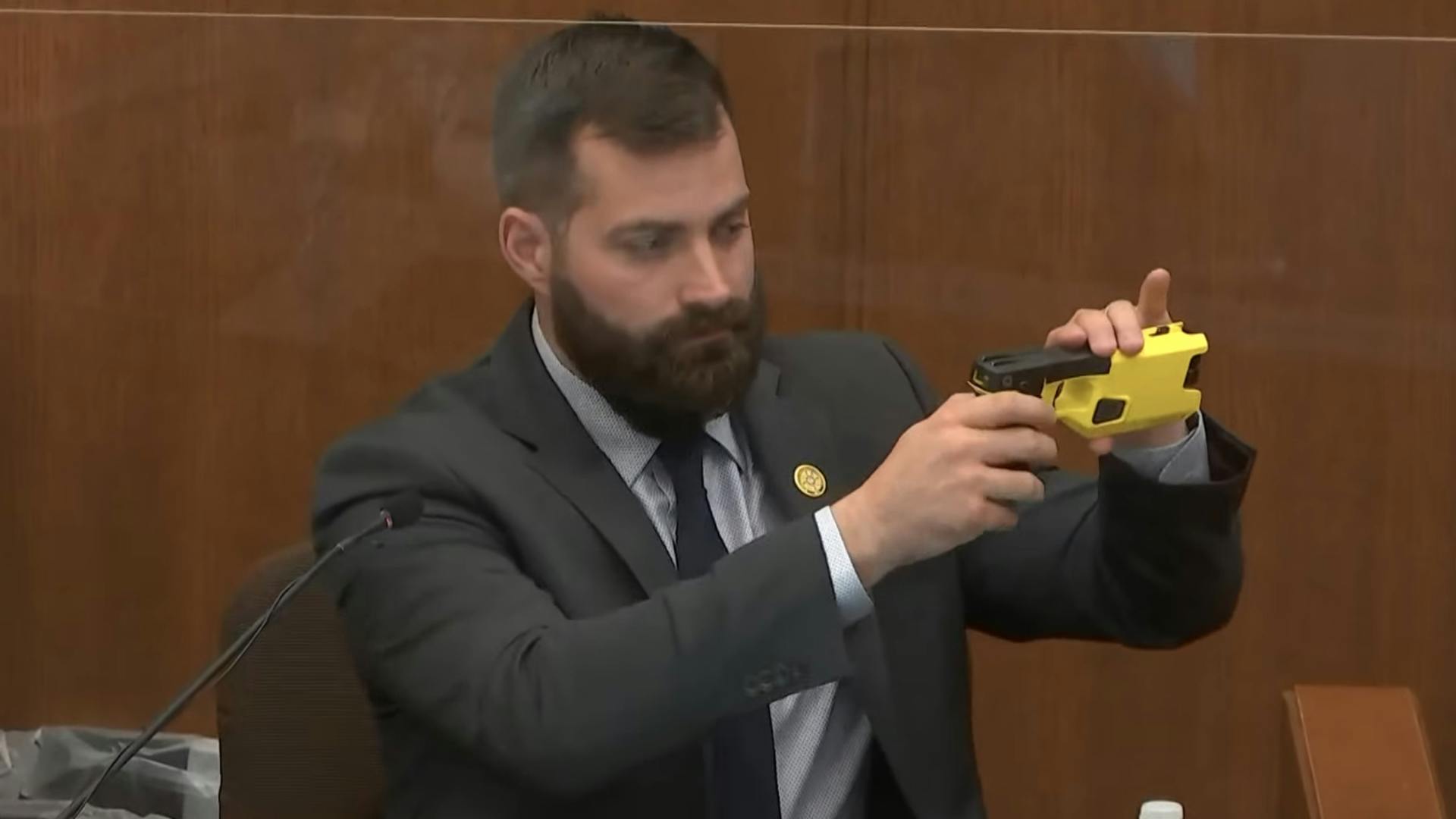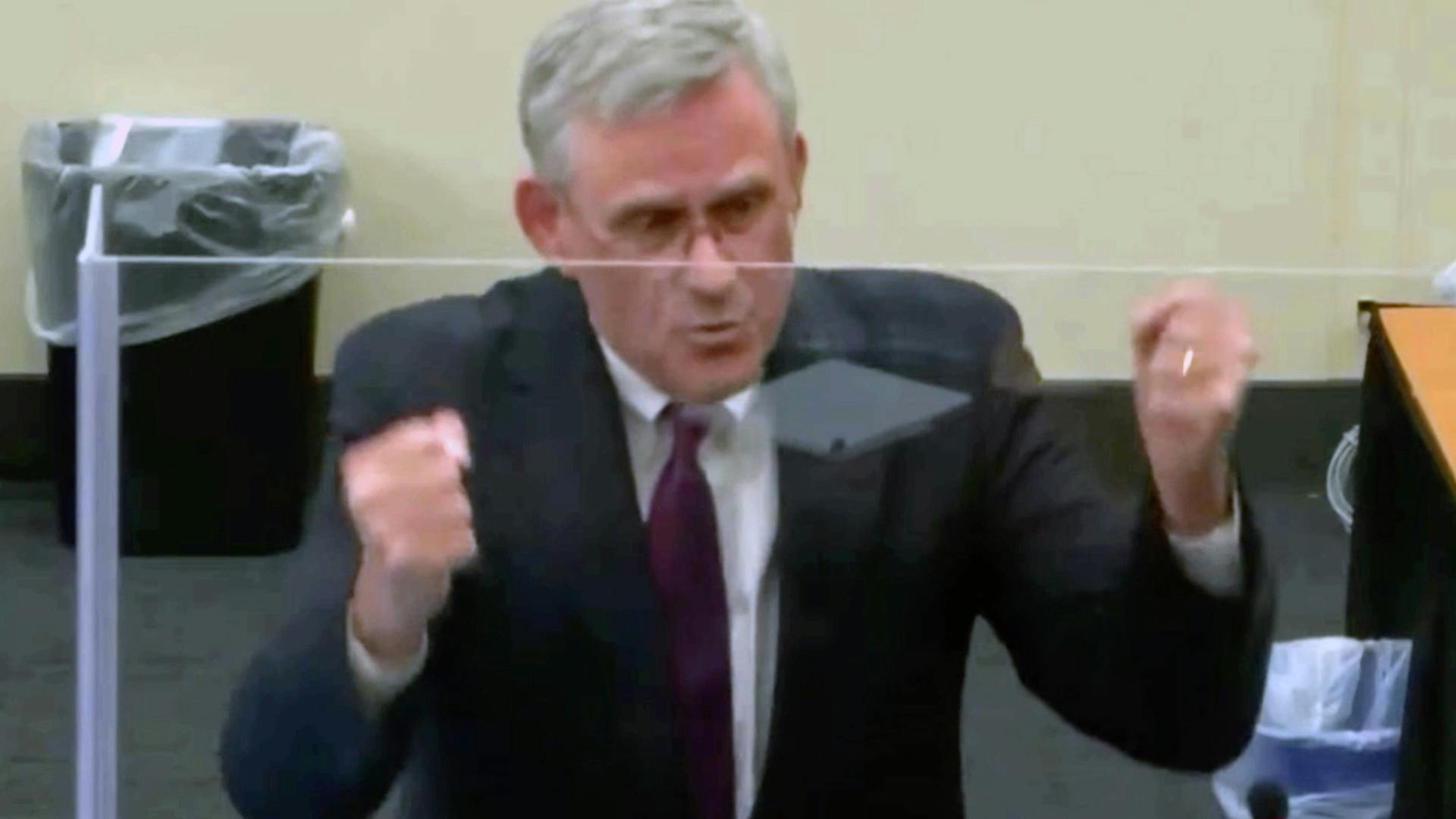A state Bureau of Criminal Apprehension Agent testified in the manslaughter trial of Kimberly Potter on Monday that there numerous distinct differences between the Taser and the gun that the former Brooklyn Center police officer carried on the day that she drew her firearm while yelling "Taser! Taser! Taser!"
Agent Sam McGinnis was led through by prosecutor Joshua Larson on each component of a Taser during his testimony in Hennepin County District Court and then compared them to the handgun Potter used on April 11, when she shot 20-year-old Daunte Wright as he attempted to flee arrest. Potter contends she drew her gun while meaning to fire her Taser.
McGinnis said Potter's handgun weighed 2.11 pounds with 17 rounds, explaining that the gun was loaded when weighed because "that would have represented what was in the firmed [on] the date of the incident."
Her Taser weighed 0.94 pounds, McGinnis said.
Larson then walked McGinnis through many other differences: A Taser has a stockier body, a smoother grip, a much shorter handle, a flat trigger vs. a gun's curved trigger.
McGinnis then activated the Taser and showed the jury the LED lights, lasers and flashlight. The device also beeped as it turned on.
He testified that Brooklyn Center police officers were required to perform a "spark test," or functionality test, of the Taser before each shift. An audit found that Potter conducted the test six out of her last 10 shifts. She last did so April 9, two days before Wright was shot.
Asked by Larson if that was noteworthy, McGinnis said "It was." When Larson repeatedly attempted to ask whether that was in violation of Brooklyn Center police policy, he was stopped over defense objections.
Defense attorney Paul Engh had McGinnis agree to some similarities. Both have a black handle and black top.
And like a gun, Engh continued, a Taser "is designed so you hold it in your hand, it's designed so you pull the trigger like a gun and it's designed so you aim it at somebody, right?" McGinnis agreed.
Under questioning, McGinnis testified that the model of Taser that Potter was using was just purchased by Brooklyn Center police in March, one month before the shooting.
"In fact the only person who had a Taser 7 was, at the time, Officer Potter?" Engh asked.
"I'd have to take your word for it, I'm not sure how many they had rolled out at that time." McGinnis said.
At one point during the prosecution's questioning, Larson was about to have each juror hold the Taser and handgun in an apparent attempt to let them feel the difference.
The defense objected. Judge Regina Chu upheld the objection, saying that the Taser and gun will be available to jurors during deliberations and "won't be functional."
The fourth day of testimony concluded about 3:45 p.m. The trial resumes Tuesday morning.
The trial opened Monday with testimony from a medical examiner who detailed the fatal injuries to Daunte Wright's body after he was shot .
Under questioning by prosecutor Erin Eldridge, Assistant Medical Examiner Lorren Jackson walked through photos that showed the bullet's entry on the lower left side of the chest, its passage through both lungs and heart before it remained in the body just before the skin on his right chest.
Potter, 49, is charged with first- and second-degree manslaughter in connection with the shooting of the 20-gear-old Wright on April 11. The 26-year police veteran contends she intended to use her Taser as Wright resisted arrest but shot her firearm instead. The prosecution contends she acted in a reckless and negligent manner when she killed Wright.
Jackson testified that the most significant injury was to Wright's heart, and more than 3 liters of blood were found in his chest.
"That's significant because an individual of Mr. Wright's size would have 4.5 to 5 liters of blood in his entire body, and when you lose half of that rapidly, your condition becomes critical."
He said Wright's wound was not survivable, with death likely in seconds to minutes, and the loss of consciousness between 10 to 15 seconds.
All of the photos of Wright's body, including him on the grass at the scene, where his vehicle crashed seconds after the shooting, were kept off the livestream but shown to the courtroom's occupants, which included Potter.
Much of the prosecution's goal in going through much of what has already been established in testimony so far is to get on the record the cause and manner of Wright's death. Jackson said he concluded that Wright died from a gunshot wound to the chest, and the manner was by homicide, which he said is defined as death "at the hands of another" and is not an indication of criminality.
Roughly 30 photos, one of them an illustration showing the bullet's trajectory, were shown in the courtroom. There were more photos available, but Judge Regina Chu limited the number shown to avoid prejudicing the jury.
Jackson also said that toxicology tests revealed marijuana use in Wright's body, a point that the defense has brought up numerous times during the trial.
Under questioning by defense attorney Earl Gray, Jackson testified that Wright had 43 nanograms per milliliter of THC, the active ingredient in marijuana, in his body. Asked by Gray whether that was a high amount, Jackson said "It's on the high end of numbers that I see, yes." He also said it was possible that Wright could have been alive for up to a minute when the car sped off.
Under redirect questioning by Eldridge, Jackson said that "Relative to the gunshot wound, there is no importance of the level of THC in his system."
Gray countered, asking Jackson: "I was not implying that was a cause of death, I was just asking what was in his blood, correct?"
Jackson agreed.
Testimony followed from Melissa Loren, a state Bureau of Criminal Apprehension (BCA) forensic scientist, who collected evidence from inside Wright's car.
As Loren walked through her actions on the day of the shooting and the next day, many photos were shown of blood throughout most of the driver's side and passenger side area, including large amounts on Wright's seat and spatter on the ceiling above. Some of these photos drew objections from the defense that the judge overruled.
Loren also explained how she located a spent cartridge case from Wright's seat, presumably from Potter's gun. Then prosecutor Joshua Larson approached the witness and showed her an open box that she confirmed held Potter's firearm, its magazine and many live rounds.
On cross-examination, defense attorney Paul Engh revisited the issue of Wright's marijuana use. Loren confirmed that she collected "plant material" from the driver's side floor that she identified visually as marijuana but added that it's not her job to testing.
Loren also said a digital scale, a common item possessed by drug users, was taken into evidence. But a prosecution objection to this line of questioning soon followed and was sustained.
BCA Special Agent Brent Petersen took the stand next and testified of responding to the scene and reviewing evidence, including body camera and dash camera footage.
As a composite video rolled in court, Potter's right hand went to her holster on that side, which held her firearm. Petersen said, "It appeared to me… a manipulation in some way of her hoslter. . I've seen it before on other videos of other officers and myself. It just caught my attention."
He went on to described it as an unlatching and "the first level of protection or safety, just to give myself an advantage should I draw."
Prosecutor Joshua Larson walked him through composite videos trying to show that Potter's former supervisor Mychal Johnson was not inside out of the passenger compartment of the car during the brief struggle with Wright. The line of questioning was in effort to rebut Johnson's testimony last week that he could have been dragged and possibly killed when Potter fired at Wright.
The defense objected to Larson walking Petersen through the video and pausing to ask Petersen what he saw, with Gray repeatedly saying "the video speaks for itself." After the jury was dismissed, Chu sided with the defense.
"The video evidence is the evidence, that's my ruling on that and there's no need for this officer to testify as to what the video evidence shows. You can show that to the jury."
She reminded the prosecutors that they can assert during closing arguments that Johnson was not at risk of being dragged, the judge said, adding, "The jury is going to have that video [during deliberations]. They can look at it as much as they want."
BCA Assistant Special Agent in Charge Michelle Frascone testified of briefly spending time with Potter after the shooting, but alerted her supervisor of a potential conflict of interest because they knew one another professionally. She took firearms from Potter and Johnson and documented them.
On Friday, Johnson testified that Wright's persistence in evading arrest on a weapons violation justified the use of deadly force.
Johnson, now a major in the Red Wing-based Goodhue County Sheriff's Department, was reaching through the passenger door to try to restrain Wright at the time.
In cross-examining Johnson, defense lawyer Earl Gray asked: "Based on these [police body camera] videos, and the conduct of Daunte Wright, as far as you're concerned ... Kimberly Potter would have had a right to use a firearm, right?"
Johnson answered, "Yes."
Given Wright's resistance to arrest for the weapons charge, Johnson said state law allowed Potter to use deadly force against Wright. Johnson's camera captured dialogue that Gray highlighted.
"You said, 'Kim, that guy was trying to take off with me in the car,' " Gray said. Johnson responded, "Yes."
"And if he had taken off with you in that car halfway," Gray continued, "what would have happened to you? What do you think would be the worst that would happen?"
"Probably dragged," Johnson answered before agreeing with Gray's assertion that he also was at risk of serious injury or death.
"And if that were the case," Gray continued, "would an officer in your position, with officer Potter trying to stop [Wright] from resisting with you and resisting [fellow officer Anthony] Luckey, would it be fair for that officer to use a firearm to stop him?"
Johnson replied, "By state statute, yes."
Prosecutor Matthew Frank followed and asked about officers needing to be aware of the danger to bystanders when using firearms. He noted how close Potter was to Johnson and Wright's girlfriend in the passenger seat when she fired.
"Could [Potter] have shot you?" Frank asked, and Johnson responded, "yes." Johnson also agreed with Frank that the car drove off only because Potter fired her gun and after he had already gotten out of the vehicle.

Want to share info with the Star Tribune? How to do it securely

'Safe recovery sites' would offer syringes, naloxone and more to people using drugs. The plan could be in peril.
New Minnesota GOP leaders seek peace with party's anti-establishment wing

Who is Republican Lisa Demuth, Minnesota's first House speaker of color?




